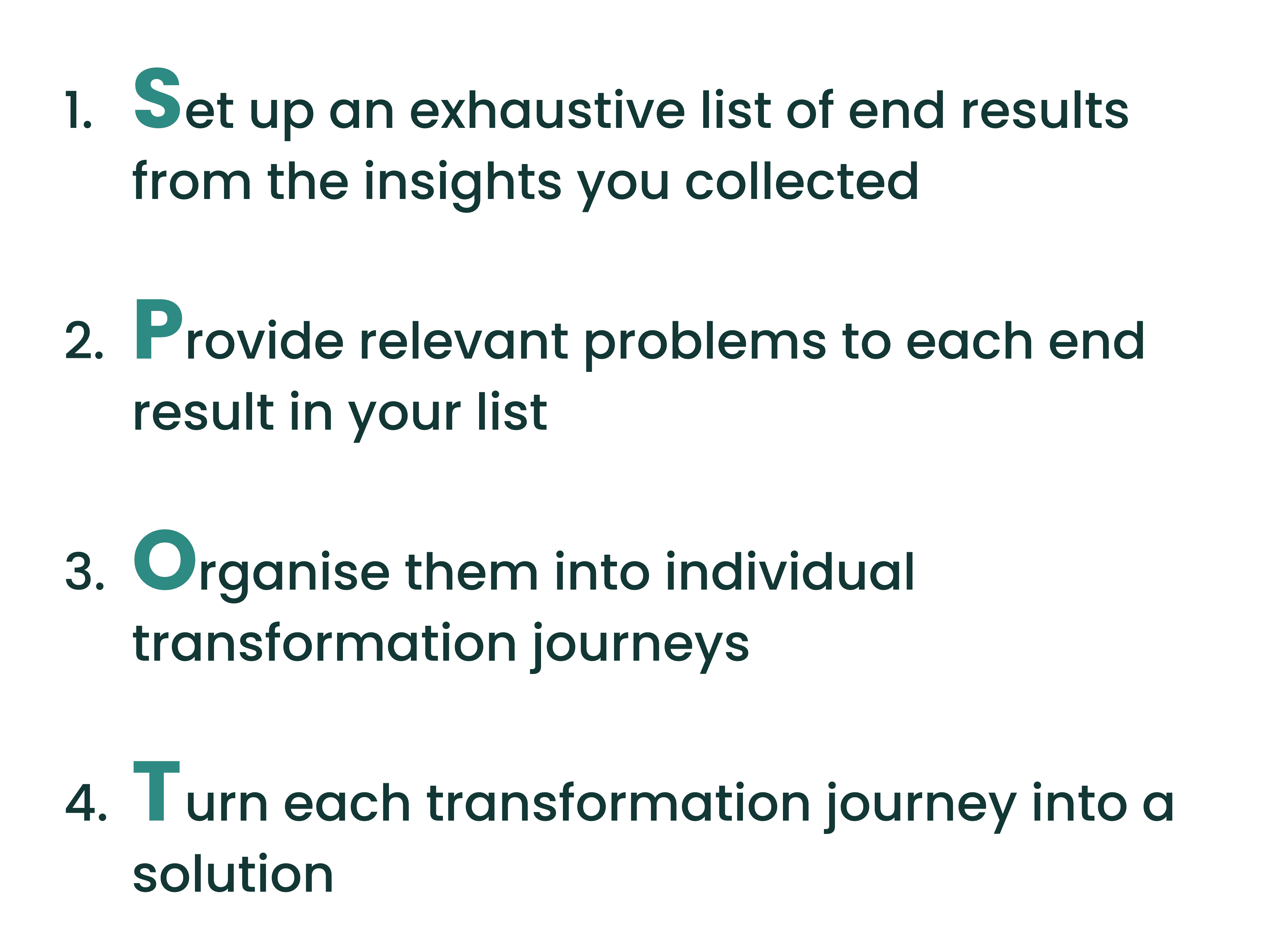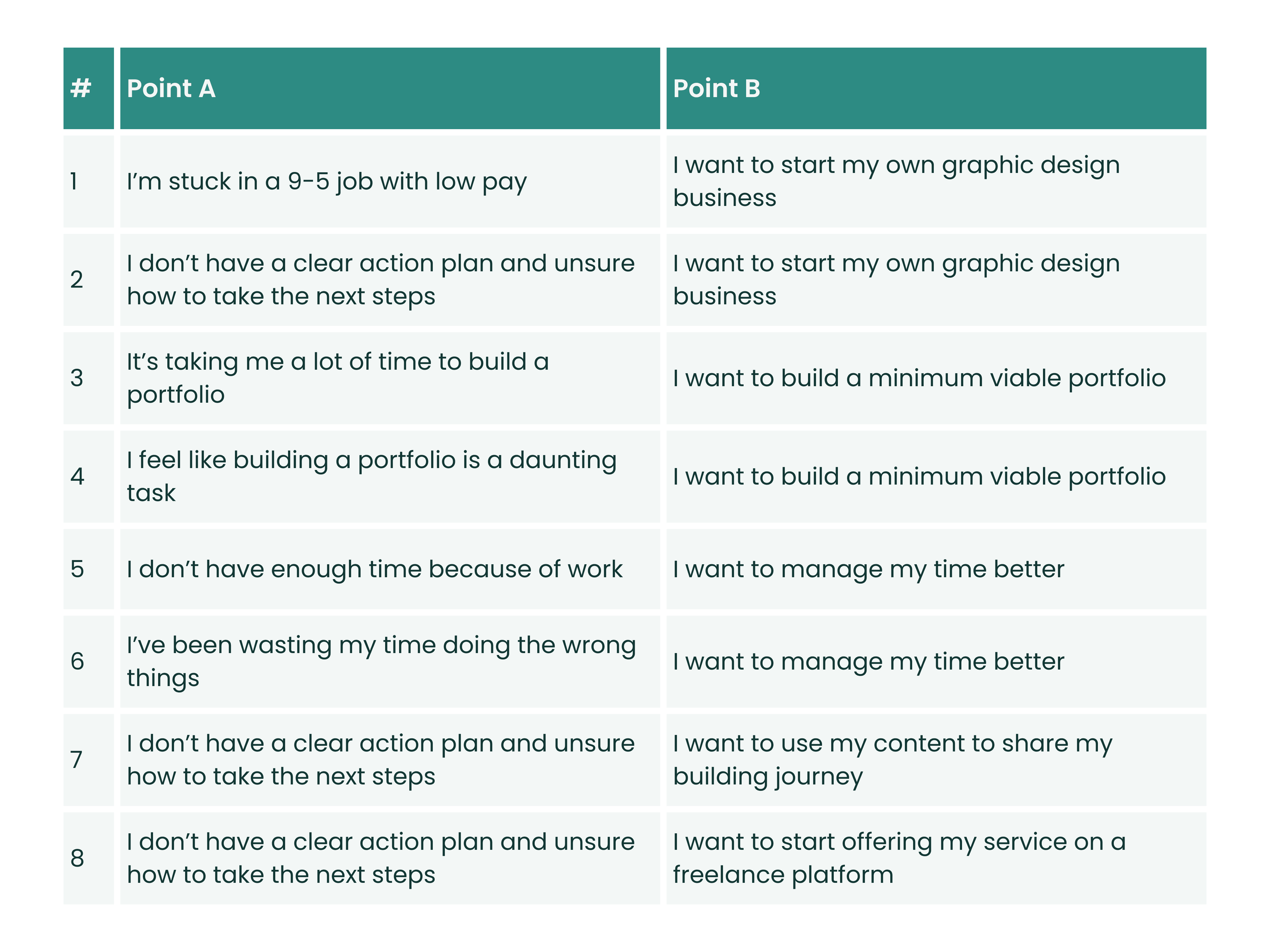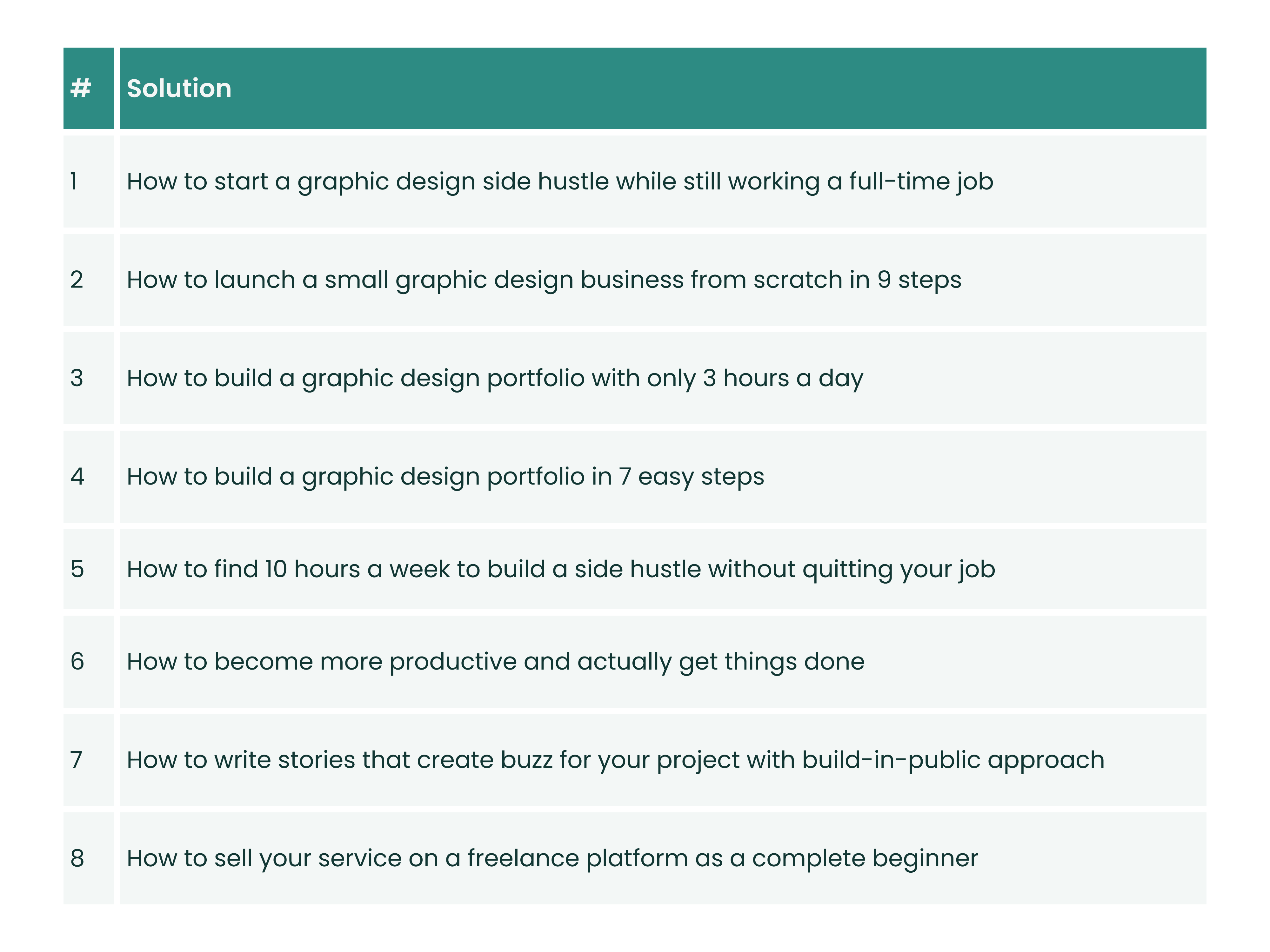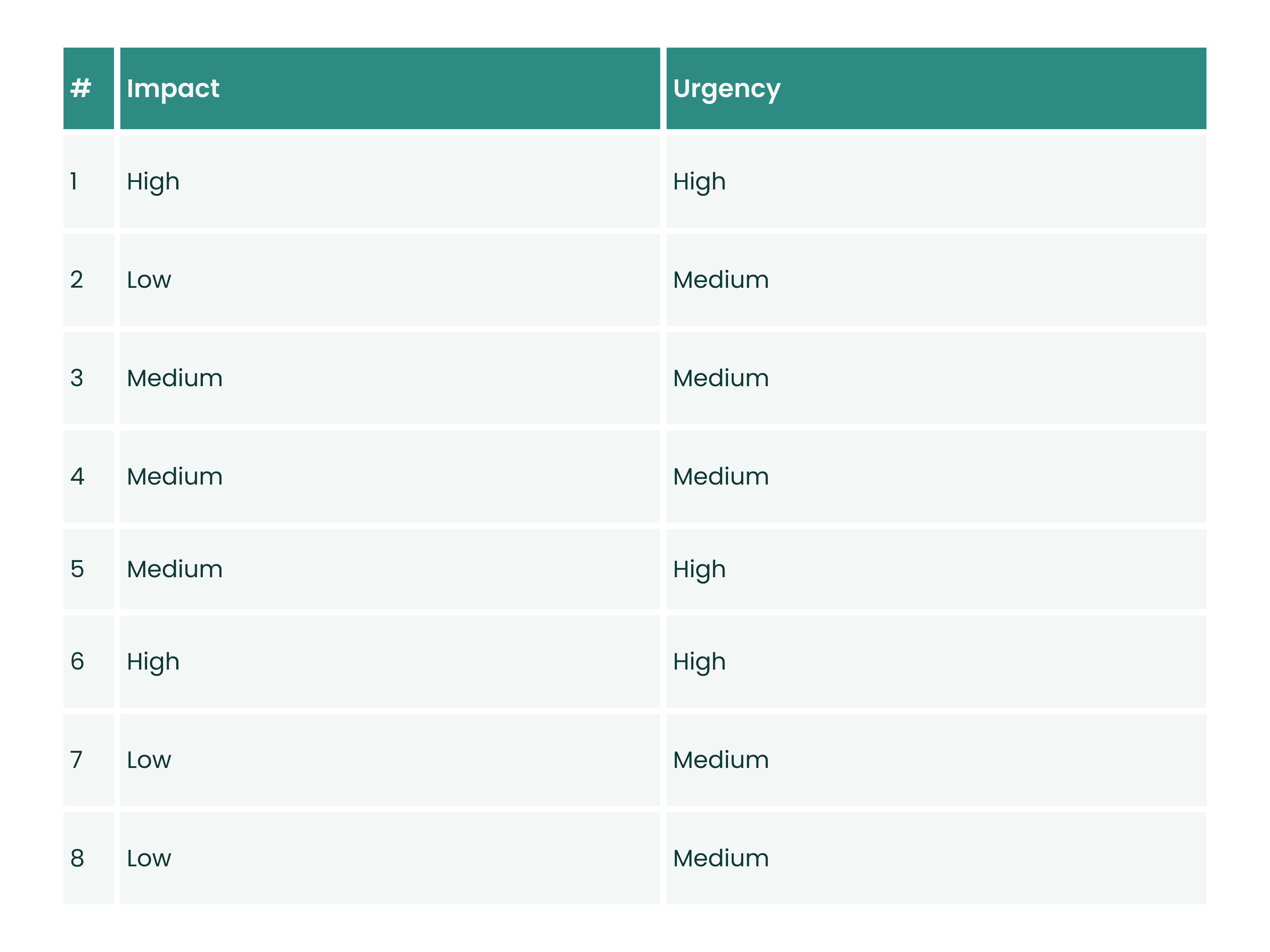What to build?
CHAPTERS
Remember how the definition of a niche we agreed on has two parts?
The previous chapter is all about the first part, the WHO.
Now that you’ve learnt how to define who to serve, where and how to find them online, and what insights to collect during your research, the next step is to figure out the second part.
The HOW.
That’s where this chapter comes in.
Turn your insights into a solution
At this stage, your priority should be to think about the value you can provide your audience through your infroproduct.
But what exactly do I mean by value in this case?
Value is a transformation journey your audience needs to progress from where they’re now to where they want to be.
This is why I asked you to note down both problems and end results during the research step from the previous chapter because they fit perfectly within a transformation journey:
Where they’re now → Problem
Where they want to be → End result
Think of this transformation journey as something your audience has to go through to get from Point A to Point B. The only thing you’re missing now is the solution that bridges these two points.
That’s what you’re going to build as your infoproduct.
But first, you’ll need to spend some time to analyse all the insights from your note before you can come up with the product idea to build upon.
So, book a session with yourself to go through this SPOT framework:

Make sure each transformation journey is only made up of a single problem and a single end result here.
Example
By using the SPOT framework, the following is what I’ve done from the first to the last step:
1. Set up
I’ve boiled down all the insights on end results from the previous example to the following (re-written for simplification without losing specific wording they used):
I want to start my own graphic design business
I want to build a minimum viable portfolio
I want to manage my time better
I want to use my content to share my building journey
I want to start offering my service on a freelance platform
Some of them might feel more difficult to achieve than others. Don’t worry just yet.
The goal now is to make sure your list captures every single possibility of end results from your note and that there are no overlaps of end results.
2. Provide
I’ve then assigned each end result with its associated problems (re-written for simplification without losing specific wording they used):
I want to start my own graphic design business
I’m stuck in a 9-5 job with low pay
I don’t have a clear action plan and unsure how to take the next steps
I want to build a minimum viable portfolio
It’s taking me a lot of time to build a portfolio
I feel like building a portfolio is a daunting task
I want to manage my time better
I don’t have enough time because of work
I’ve been wasting my time doing the wrong things
I want to use my content to share my building journey
I don’t have a clear action plan and unsure how to take the next steps
I want to start offering my service on a freelance platform
I don’t have a clear action plan and unsure how to take the next steps
3. Organise
From the list above, I’ve mapped them into eight individual transformation journeys:

4. Turn
Finally, I’ve turned each transformation journey above into a single solution that would benefit my audience.
Here are a few tips to help you come up with solutions more easily:
Ask yourself how YOU can help them (it has to be within your ability)
Think about what exactly they need (that they don’t have or don’t know right now) to get from Point A to Point B
Start each sentence with “How to” to stay focused on the value your solution delivers instead of the format of your solution

Make a decision
Once you’ve got everything laid out nicely in front of you, it’s time to pick one you’ll go ahead with.
How can you do this?
Well, let me remind you again that your goal is to build something your audience actually uses.
This means your decision should be based more on them and less on yourself. Make them your top priority.
You’re going to assess each transformation journey on two criteria:
Impact → How much does this problem affect them or how costly is this problem to them both financially and emotionally
Urgency → How much do they need this problem solved or how much pain are they in because of this problem now
Rank each transformation journey with “High”, “Medium”, or “Low” on both criteria.
Once you’ve assessed all of them, your priority is to move forward with the one that scores “High” on both criteria. These are likely the ones your audience has expressed with strong word choices that show some of these signs:
Problem
Suffering
Frustration
Desperation
End result
Eagerness
Excitement
Enthusiasm
Now, you may have a few that score “High” on both criteria. That’s totally fine. Having too many choices is better than having nothing.
Here’s a quick guideline to help you settle with just the one:
Pick the one with the problem you saw showing up most often during your research
If you still can’t decide, pick the one that’s the fastest for you to build and deliver
If you still can’t decide, pick the one that you’d enjoy working on the most
If you still can’t decide, just pick one and move on!
Don’t overthink too much if you can’t decide. What’s important at this stage is to get going rather than get stuck planning forever.
Example
Based on the previous example, I’ve ranked each transformation journey as follows:

The first and the sixth came out on top here.
But looking back at the Reddit post I chose, the problem of getting stuck in a 9-5 job has been mentioned at least three times compared to the problem of wasting time which has only been mentioned once.
Therefore, I’ve decided to go ahead with the first transformation journey:
Point A → I’m stuck in a 9-5 job with low pay
Point B → I want to start my own graphic design business
Solution → How to start a graphic design side hustle while still working a full-time job
Package everything up
So far, you’ve found:
The problem to solve
The end result to achieve
The solution to deliver to your audience
You’re almost there.
The last step of this chapter is to package your solution into something your audience wants.
But how do you know which format to choose?
One thing to remember is that your goal is to move fast at the beginning.
You don’t need to build anything life-changing at all, you just need to build something good enough to help someone solve a problem and achieve the end result they want.
Build your first momentum with this.
Start with something that’s the simplest and fastest for you to build while still being valuable enough for your audience.
Forget about a subscription or anything that delivers value on a recurring basis first (e.g., community, coaching program, membership). Instead, go for something with one-time value delivery.
Here are some of the proven formats to help you get started:
Guide
Ebook
System
Template
Mini course
Live workshop
Notice how the value delivered by each example above is information and not implementation (which takes a lot more of your time and effort to build and deliver).
Here’s a quick guideline to help you pick the format:
Play to your strength (if you prefer writing, don’t build a mini video course or live workshop and vice versa)
Go for the one that you have experience building before
Revisit the insights on end result from your research, especially recommendations, to pinpoint the format your audience prefers
Example
Going with “How to start a graphic design side hustle while still working a full-time job”, this is how I’ve made my decision.
I’ve first eliminated a template and a system because they aren’t the right fit for this kind of solution.
The success of a mini course and a live workshop depends highly on video quality. Therefore, I’ve also eliminated both since they don’t play to my strength which is writing.
Between a guide and an ebook, I’d go with the first because it’s more concise and easier to consume. But more importantly, I’ve written this style of content many times before.
Finally, I’ve cross-checked with my research note and found that there was a preference for an action plan with step-by-step guidance. This is perfect for a guide and hence the format I’ve chosen.
PREVIOUS
Found this guide valuable?
Leave your testimonial here.
